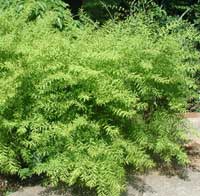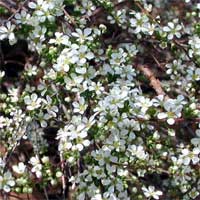Resource Library
Plant of the Week: Spirea, Mellow Yellow
The University of Arkansas System Division of Agriculture does not promote, support or recommend plants featured in "Plant of the Week." Please consult your local Extension office for plants suitable for your region.
Plant of the Week
Mellow Yellow
Latin: Spiraea thunbergii ‘Ogon’

Deciduous spring-blooming shrubs have enjoyed a comeback in gardens during the past decade.
A century ago they were the mainstay of the landscape but gradually lost favor as gardeners began to rely more heavily on evergreens to provide year-round color. During this renaissance, spireas have really surged in popularity, with Ogon Thunberg spirea becoming my favorite.
Spiraea thunbergii ‘Ogon’ - also sold as Mellow Yellow spirea - is a 5- to 6-foot tall deciduous shrub with thin, twiggy branches that grows into a gracefully mounded, multi-stemmed shrub. The slender, willow-like leaves are to 2 inches long.
In the spring, unfurling leaves take on a subtle chartreuse color that gradually changes to green as the summer heats up. Late in the fall, usually after Thanksgiving here in north Arkansas, it produces beautiful orange-yellow to plum colored fall foliage.
Of the spireas, this species is the earliest to bloom, usually flowering in the first half of March with forsythia. Spireas belong to the rose family and have the small, white, five-petaled blossoms characteristic of many members of that family. The blooms are about a quarter-inch across but borne in considerable profusion.
Though the species, often called “Baby’s Breath Spirea,” was introduced in the 1860s, Ogon is new, first introduced into the United States in 1993 by Pennsylvania plantsman Barry Yinger who found it at a garden center in downtown Tokyo. Yinger is one of the modern day breed of plant explorers who have introduced many new plants into American gardeners during the past decade.
Instead of spending years traveling through remote places in far off lands, modern plant explorers make a number of short, highly-focused visits to an area. They make a special effort to get to know local nurserymen, gardeners and the plants they grow in their own gardens. Yinger has made more than 60 trips to Japan and has introduced most of his Asian plant finds through California’s Hines Horticulture, a large container nursery operation for whom he serves as a globe-trotting director of research.

Yinger, now in his mid 50s, aspired to be a plant collector from childhood. His studies at the University of Maryland in horticulture and Asian languages were towards that end. After several years working for public gardens with their miniscule budgets for exploration, he landed the Hine’s job and has been collecting important plants that have almost instantaneous national impact. Tragically, in 2003, the 1880s era barn that had been converted into his home and office burned, destroying all of his field notes and a specialized library of more than 6,000 books and catalogs on Asian plants.
Ogon spirea is a versatile shrub in the landscape. It can be mixed with evergreens where its fine texture and beautiful chartreuse foliage brightens the drab greenery. But it’s small enough to incorporate in the back of a perennial border where it can function as a harmonious part of the planting. I use it as a stand-alone specimen beside the drive. The foliage color is very subtle and blends with almost any color combination.
Size control is easy by cutting the plant back in the spring as soon since flowers fade but before the plant fully leafs out. It tends to be a bit irregular growing but these wispy branches add to the soft textural feel of the shrub. Ogon spirea is best grown in full sun in average soil conditions. Once established it has excellent drought resistance.
By: Gerald Klingaman, retired
Extension Horticulturist - Ornamentals
Extension News - May 5, 2006
The University of Arkansas System Division of Agriculture does not maintain lists of retail outlets where these plants can be purchased. Please check your local nursery or other retail outlets to ask about the availability of these plants for your growing area.